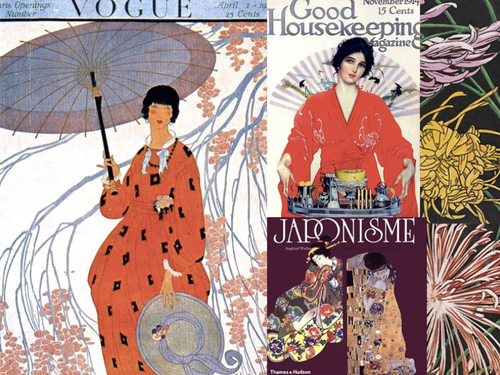



















Japonism ~ Art History ~ Western Art & Japan Trade Opening ~ 1800s ~ 212 Slides
This is a very complete presentation of the Japonism Movement in Art History, which occurred when Western Art was exposed to the opening of Japanese Trade in the 1800s . There are ample slides in the slideshow on this page for a full preview of the product.
text excerpt:
Japanese trade to the West began in 1859 so that Oriental art and household goods were sold in Europe. Among artists, it was the Japanese Prints which caught their eyes. They were very different from Western art. The colors were much brighter and more exotic. The Japanese also had a different sense of spatial relationships from Westerners.
Western artists eagerly adapted the new things they saw in the prints into their own work. Japonism, Japonisme, and Japanomania are the terms for the western craze for Japan. By the turn of the century, Africa followed Japan as the culture craze, just in time to be discovered by the Cubists.
Japan showed its art and household goods at the World Fair in London in 1862 and Paris in 1867. Kimonos, fans, parasols, lacquerware, screens and prints became all the rage.
text excerpt:
Some artists staged Japoneries (Tableaus), which featured models dressed in kimonos amidst Japanese props. This was their idea of adapting their art work to this new Japanese inspiration.
These Japoneries look extremely dated, staged and derivative today.
Degas and other major artists did not go in that direction.
Instead, Degas used the qualities of the Japanese aesthetic and adapted those to his own imagery. Thus, he put his dancers in an elongated pictorial format with an asymmetrical composition.
He did NOT put his dancers into kimonos and bedeck them with Japanese props. The successful result is shown below.
text excerpt:
Although this painting by Monet of his wife Camille is also a Japonerie, it is the only one Monet paints. His others are his own imagery, just like Degas did.
The Monets loved Japonism. Claude Monet acquired 250 Japanese prints, which covered the walls of his house in Giverny. Camille wore a kimono around the house. The garden at Giverny is modeled after a Japanese print with the arcing bridge and bamboo.
text excerpt:
“All my work is based to some extent on Japanese art…"
Vincent to his brother Theo from Arles, 15 July 1888
This is a very complete presentation of the Japonism Movement in Art History, which occurred when Western Art was exposed to the opening of Japanese Trade in the 1800s . There are ample slides in the slideshow on this page for a full preview of the product.
text excerpt:
Japanese trade to the West began in 1859 so that Oriental art and household goods were sold in Europe. Among artists, it was the Japanese Prints which caught their eyes. They were very different from Western art. The colors were much brighter and more exotic. The Japanese also had a different sense of spatial relationships from Westerners.
Western artists eagerly adapted the new things they saw in the prints into their own work. Japonism, Japonisme, and Japanomania are the terms for the western craze for Japan. By the turn of the century, Africa followed Japan as the culture craze, just in time to be discovered by the Cubists.
Japan showed its art and household goods at the World Fair in London in 1862 and Paris in 1867. Kimonos, fans, parasols, lacquerware, screens and prints became all the rage.
text excerpt:
Some artists staged Japoneries (Tableaus), which featured models dressed in kimonos amidst Japanese props. This was their idea of adapting their art work to this new Japanese inspiration.
These Japoneries look extremely dated, staged and derivative today.
Degas and other major artists did not go in that direction.
Instead, Degas used the qualities of the Japanese aesthetic and adapted those to his own imagery. Thus, he put his dancers in an elongated pictorial format with an asymmetrical composition.
He did NOT put his dancers into kimonos and bedeck them with Japanese props. The successful result is shown below.
text excerpt:
Although this painting by Monet of his wife Camille is also a Japonerie, it is the only one Monet paints. His others are his own imagery, just like Degas did.
The Monets loved Japonism. Claude Monet acquired 250 Japanese prints, which covered the walls of his house in Giverny. Camille wore a kimono around the house. The garden at Giverny is modeled after a Japanese print with the arcing bridge and bamboo.
text excerpt:
“All my work is based to some extent on Japanese art…"
Vincent to his brother Theo from Arles, 15 July 1888
Something went wrong, please try again later.
This resource hasn't been reviewed yet
To ensure quality for our reviews, only customers who have purchased this resource can review it
Report this resourceto let us know if it violates our terms and conditions.
Our customer service team will review your report and will be in touch.
$5.00